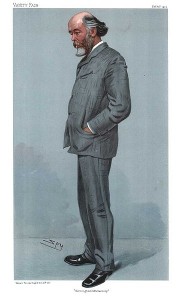
In 1898, Sir Oliver Lodge (1851-1940) patented the first syntonic or tuned radio system. Ironically, the very patent that inaugurated this fundamental concept of narrow-band, frequency-domain radio also disclosed some of the first ultra-wideband (UWB) antennas:
As charged surfaces or capacity areas, spheres or square plates or any other metal surfaces may be employed; but I prefer, for the purpose of combining low resistance with great electrostatic capacity, cones or triangles or other such diverging surfaces with the vertices adjoining and their larger areas spreading out into space; or a single insulated surface may be used in conjunction with the earth, the earth or conductors embedded in the earth constituting the other oppositely-charged surface [U.S. Patent 609,154]
The figure from his patent (below the break) makes clear that he was thinking of what we would now call a biconical antenna. In another figure, he shows what modern antenna engineers would recognize as a bow tie antenna. But Lodge was ahead of his time. I’ve noted elsewhere how early radio was narrow band in conception but ultra-wideband in practice. As spark gap transmitters were supplanted by more efficient continuous wave sources, Lodge’s pioneering work was largely forgotten. I recounted the re-discovery of the biconical antenna by Phillip Carter (see U.S. Patent 2,175,252) in the 1930’s in my book (p. 14). More recently, I learned that the biconical antenna was independently discovered yet another time, for a total of at least three.

Here’s the account from Harold Wheeler:
A conical dipole is shown in Fig. 2. I thought of this as an improvement for wideband operation. I was attracted to its simplicity and I was able to compute its impedance. In preparing a patent application, my attorney came up with an old book by Sir Oliver Lodge. He showed the conical dipole with a spark gap in the middle for use as a transmitter. He showed the surrounding spherical-wave pattern. So we did not file an application.
I had a friend a few years older, Phillip S. Carter, who was an antenna expert in RCA out on Long Island. Unknown to me, he alsothought of the conical dipole. Apparently he did not find the Lodge book and neither did the Patent Office, so he obtained patents on the conical dipole as a wideband antenna. Perhaps our use for it really did amount to an invention that was patentable over Lodge. My work was 2 or 3 years ahead of his filing dates.
[Harold Alden Wheeler, The Early Days of Wheeler and Hazeltine Corporation – Profiles in Radio and Electronics, (Poughkeepsie, NY: Hamilton, Reproductions, Inc., 1982), p. 272].
On one level this is an amusing anecdote and we can chuckle at the ignorance of the practitioners and patent examiners who do not understand the history of their art. But the bottom line is that a couple of the most productive, significant, and successful antenna designers of the 1930s wasted substantial amounts of time rediscovering antenna concepts that were already in the art. All too often, ideas that aren’t immediately used are forgotten, and a generation later must be rediscovered as technology catches up with the visionaries of the previous generation. Offbeat notions abandoned by the previous generation as impractical have a habit of becoming useful as their limitations are rectified by the advance of technology. The moral of this story is that the history of any technical field can yield very valuable and time-saving insights to the modern-day practitioner.

